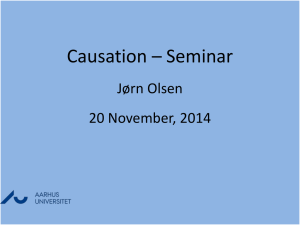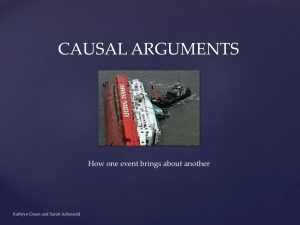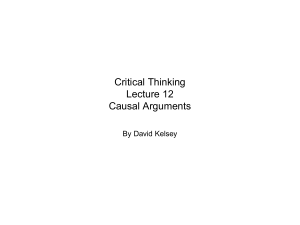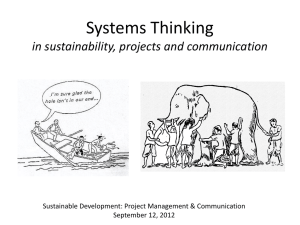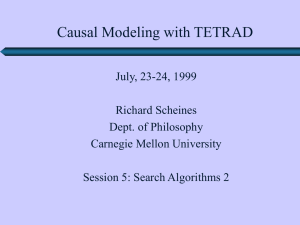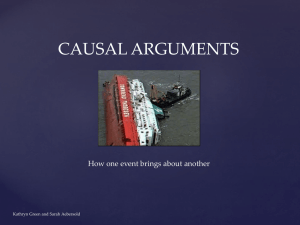slides
advertisement
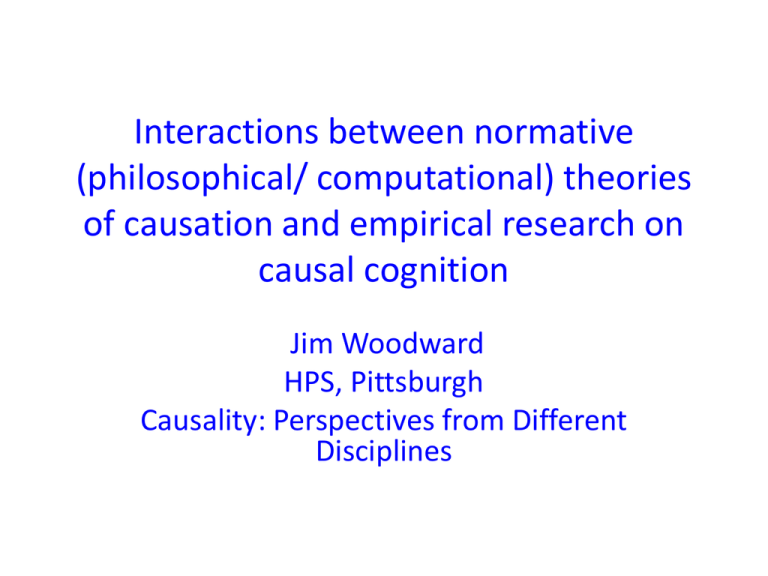
Interactions between normative (philosophical/ computational) theories of causation and empirical research on causal cognition Jim Woodward HPS, Pittsburgh Causality: Perspectives from Different Disciplines Overview Two Sets of Distinctions: 1) (a) Normative versus descriptive projects (b) Distinguishing causal from non-causal claims versus making further distinctions within the general category of causal claims. My focus in this talk will be on (1b). I will use work on stability and double prevention and on “proportionality” and the choice of “level” of explanation to illustrate interactions between normative and descriptive theorizing. Two different projects regarding causation 1) Normative projects. Purport to tell us how we ought to learn about, reason about causal relationships and make causal judgments. 2) Descriptive/empirical projects: how do people (and other subjects) learn about, reason about, judge wrt causal relationships. What is relation between these? I see them as closely related and think that each can be fruitfully influenced by the other. In other words, Interactions can flow in both directions. First, theories of causation can suggest psychological hypotheses and possible experiments. Second, psychological results can also be suggestive for normative/ philosophical theories One key to appreciating this is thinking of normative theories as providing benchmarks or ideals with which actual performance can be compared. Explaining Success This in turn connected to two other ideas. 1) The importance of explaining success. Part of task of descriptive theories is to explain why causal learning and causal judgment of various subjects is successful to the extent that it is. Analogy with visual system. Similarly descriptively adequate theory of causal learning, judgment etc. should explain success, just as in the analogous case involving the visual system. For example, if our normative theories suggest that learning about the causal structure of the world will be successful if our learning strategies possesses feature F, we should check whether human or other subject causal cognition has feature F this might help to explain success. Conversely, if we see that as a matter of empirical fact people’s causal cognition and learning exhibits certain features F, we might want to at least consider the possibility that some of these features F contribute to such success and thus are candidates for incorporation into normative theory. Thinking About Causation Functionally 2) The importance of trying to understand causal learning, reasoning and judgment in functional terms. This means thinking about causal cognition in terms of goals or aims it attempts to serve and evaluating proposals about causal learning, judgment etc in terms of how well they achieve those goals. Causal reasoning is for various goals, not just an end in itself. General point is that in the human sciences, normative theories of reasoning and decisionmaking can often play an important role in guiding descriptive investigations. Normative theories of decision-making, reward learning as another illustration. Understanding behavior of dopamine neurons in terms of temporal difference learning, reward prediction error. What are the goals or functions of causal cognition? Interventionists think of these goals as having to do with manipulation and control, but there are other possibilities as well– e.g. perhaps the compressed, simplified, unified representation of correlational information. Or finding representations in which some structures are independent of others. A Second Distinction Also distinction between two other projects: 1) On the one hand, providing a basis for the distinction between causal relationship and non-causal (e.g. merely correlational) relationships 2) On the other hand, drawing distinctions among causal relationships. First project has received much more philosophical attention than the second. Interventionist framework for thinking about causation is directed toward the first question (distinguishing causation from something else and provides one answer to this question) : (M) C causes E if and only if there is some intervention that changes the value of C, such that if that intervention were to occur, the value of E or the probability distribution of E would change. Second project asks the following question: suppose we have various causal relationships that are minimally causal in the sense of satisfying (M). Are there further distinctions to be made among these relationships? Examples of distinctions among causal relationships (not remotely exhaustive) • Causal relationships (that is, relationships that satisfy M) can more or less stable or invariant • A cause can satisfy (M) and be proportional or at the right level for its effect or not. • Causes satisfying (M) can be more or less specific This project of making distinctions among causal relationships above also has a normative and empirical component. On the normative side, we can ask we can ask whether it makes normative sense for people to make these distinctions, given the goals they have? How if at all do these distinctions connect to functions or aims of causal thinking. On the empirical/descriptive side, we can ask whether people in fact make these distinctions in their causal judgments. My view : these are all features such we have a normative rationale for caring about whether they are present or not in causal relationships, given an interventionist framework: that is, their presence or absence is connected to possibilities for manipulation and control, as I hope to illustrate. Understanding this normative rationale can help us to understand why causal judgments possess these features (or at least that is the project I want to recommend) Stability and Double Prevention Results supporting the claim that subjects seem to care about stability in the form of Lombrozo’s experiments on double prevention relations. Double Prevention Cases in which if d were to occur, it would prevent the occurrence of e (which would otherwise occur in the absence of d) and in which the occurrence of c prevents the occurrence of d, with the upshot that e occurs. Suzy’s plane will bomb a target (e) if not prevented from doing so. An enemy pilot p will shoot down Suzy’s plane (d) unless prevented from doing so. Billy, piloting another plane, shoots down p (c), and Suzy bombs the target Overall counterfactual dependence of e on c (with the dependence in question being the sort of non-backtracking dependence associated with causal relatedness on counterfactual theories of causation) Many counterfactual theories , including Lewis’, as well as my M judge this relation to be causal But common reaction is that double prevention cases are either not cases of causation at all, or at least lack some feature which is central to many other cases of causation– absence of biff, umph, physical connection. Ned Hall: We operate with two distinct notions of causation: dependence and production. Double prevention exemplifies dependence but not production. Several questions: As a matter of descriptive psychology, how widely shared are these intuitive judgments reported by Hall and others about the causal status of double prevention? Are some cases of double prevention are regarded as more causal or more paradigmatically causal than others? Second, to the extent this is the case, what is going on when people make judgments about double prevention and production? Can we say anything further about why people bother to distinguish between production and “mere” counterfactual dependence or why they might make distinctions among different cases of double production? These are questions naturally suggested by the functional conception of causal thinking advocated earlier. Explore these questions by making use of some recent psychological experiments concerning causal judgment by Steve Sloman and Clare Walsh and by Tania Lombrozo. Walsh, C. and Sloman, S. (2011). “The Meaning of Cause and Prevent: The Role of Causal Mechanism.” Mind and Language, 26: 21–52. Lombrozo, T. 2010. “Causal-explanatory Pluralism: How Intentions, Functions, and Mechanisms Influence Causal Ascriptions”. Cognitive Psychology 61: 303-332. Lombrozo and Carey, “Functional explanation and the function of explanation” Cognition 99 (2006) 167–204 Walsh and Sloman, (2011) presented subjects with a series of scenarios, two of special interest. In first, coin is standing unstably on its edge and about to fall tails. Billy and Suzy roll marbles in such a way that each will strike the coin and in each case after impact the coin will land heads but Billy’s marble strikes first. In this scenario, 74% of subjects judged that Billy’s marble caused the coin to land heads. Results seem to support the conclusion that at least as far as folk thinking about causation goes, cases in which something like “production” or a “generating mechanism” or a “physical connection” or “transference” is present are more likely to be judged as causal than cases of double prevention. Some additional experiments, due to Tania Lombrozo complicate this picture : Lombrozo’s experiments explore people’s causal judgments about double prevention scenarios in contexts involving intentional action, artifacts with designed functions, and biological adaptations. Example of the pairs of scenarios that Lombrozo employs—the first item in the pair is the description with the material in bracket removed and the second item includes the material in brackets The diet of a certain kind of Australian shrimp consists of three kinds of foods: alphaplankton, bacterioplankton, and cromplankton. Alphaplankton contain chemical A, which triggers a reaction that changes the shrimp’s skin to make it reflect high frequencies of ultraviolet light. Bacterioplankton contain chemical B, which neutralizes chemical A and thereby prevents the shrimp from reflecting high frequencies of ultraviolet light. However, cromplankton contain chemical C, which binds to chemical B and thereby prevents chemical B from preventing chemical A from making the shrimp reflect high frequencies of ultraviolet light. Because of these interactions, a shrimp that has eaten alphaplankton, bacterioplankton, and cromplankton will reflect high frequencies of UV light. [ • [Reflecting high frequencies of UV light is biologically important, as it aids the shrimp in regulating its temperature by reflecting the frequencies of light with the most energy. In fact, while eating bacterioplankton is important for nutritional reasons, Australian shrimp have evolved to eat alphaplankton and cromplankton because these foods result in the reflection of high frequencies of UV light and thereby improve temperature regulation.] Subjects asked whether alphaplankton, bacterioplankton, and/or cromplankton caused specimen S to reflect high frequencies of UV light. Manipulation is whether subjects are told that the effect of interest is a biological adaptation (has “functional status”) or not. Lombrozo finds when effect has functional status, subjects more willing to say that is appropriate to rate cases of double prevention as “causal” than when the same effect occurs “incidentally” and not as a result of an adaptation. General pattern: although as in the Sloman and Walsh experiments, Lombrozo finds (in experiments I have not described) subjects are more willing to judge that cases involving “production” than (at least some) cases involving double prevention are causal, subjects also distinguish among cases of double prevention, treating those involving intentional action, designed function and biological adaptation as more appropriately described as causal than cases of double prevention not involving these features. What then accounts for this differential response to the different double prevention scenarios in Walsh’s and Sloman’s experiments in comparison with Lombrozo’s? Stability, insensitivity etc. : Suppose some event e (or type of event E or the values of a variable E*-- the differences won’t matter much for our purposes) counterfactually depends on another event c (or type of event C etc.), where the dependence is of the right sort to support a causal interpretation—it is nonbacktracking, supports interventions, and so on. Sensitivity of this relation of counterfactual dependence has to do with whether it would continue to hold as we change other background factors. Woodward, J. (2006) “Sensitive and Insensitive Causation.” Philosophical Review 115: 1-50. Examples: Writing a letter of recommendation vs shooting someone at point-blank range. Differences in sensitivity seem to track to a considerable extent how “good” or paradigmatic a dependence relationship is as an example of a causal relationship. That is, cases of counterfactual dependence which are relatively unstable or sensitive tend to be judged as less paradigmatically causal (as less “good” causes”) than cases of counterfactual dependence which are more stable or less sensitive My 2006 paper suggests that cases of double prevention in which there is an overall relation of counterfactual dependence between c and e can similarly vary in the extent to which this relationship is stable and conjectured that this is related to the extent to which the double prevention relation is regarded as paradigmatically causal. Billy/ Suzy example illustrates this. Contrast is with metabolization of lactose by e. coli. Similar analysis applies to Lombrozo’s examples —a claim that she also endorses. That is, double prevention relations in her examples are judged more paradigmatically causal depending on how stable they are, and similarly for examples involving designed artifacts. In other words, in all of these cases we may provide a relatively unified explanation of people’s judgments by appealing to the greater stability of the double prevention relations when adaptation, design or intention are present, in comparison with their absence. ….causal ascriptions are valuable insofar as they identify relationships that are sufficiently stable or invariant across situations to be useful in prediction and intervention. This proposal mirrors a hypothesis in Lombrozo and Carey (2006) about the function of explanation, called ‘‘Explanation for Export.” According to Explanation for Export, explanations identify factors that are ‘‘exportable” in the sense that they are likely to subserve future prediction and intervention. If the function of isolating parts of causal structure, be it in an explanation or a causal claim, is to subserve future prediction and intervention, then ‘‘good” causes should be those that reflect stable, invariant relationships that are exportable to relevant situations Lombrozo, T. 2010. “Causal-explanatory Pluralism: How Intentions, Functions, and Mechanisms Influence Causal Ascriptions”. Lombrozo’s treatment illustrates the explanatory strategy associated with the importance of thinking of causal reasoning in functional terms discussed earlier (and the associated idea about the importance of thinking in terms of normative theory) One reason why people care about the difference between causal relationships and relationships of correlation that are not direct expressions of causal dependence (as when the correlation between two effects is entirely due to a common cause) is that the former are exploitable ( at least in principle and often in fact) for purposes of manipulation/intervention and control in a way that the latter are not Once this accepted, also natural to recognize that different relationships of counterfactual dependence can serve this function or satisfy this aim to different degrees. In particular, the more stable a relationship of counterfactual dependence is, then (other things being equal) the more useful or suitable it is likely to be for purposes of manipulation and control. Note the overall strategy here: Instead of asking whether double prevention relations are “really causal” or worse trying to use our intuitions about cases to determine whether double prevention relations are really causal— an ill-posed question, in my view, we should ask: 1)Why do people (ordinary people, scientists) bother to distinguish between relations of counterfactual dependence that involve double prevention and relations of counterfactual dependence that involve physical transference or production? . Part of the answer: Other things being equal, Productive relations tend to be more stable. 2) Do people distinguish among double prevention relations and if so, why, and on what basis? Answer: they distinguish among double prevention relations with respect to their degree of stability. Proportionality and finding the right level of explanation Switch gears to another set of experiments: Yunnwen Lien and Patricia Cheng (“Distinguishing Genuine from Spurious Causes: A Coherence Hypothesis”). One of the many issues explored in this paper – this is my description— is the choice of level of abstraction at which people characterize causes. To illustrate with example from philosophical literature, consider, following Yablo, a pigeon that has been trained to peck at red and only red targets—that is, the pigeon pecks at targets of any shade of red and only these. Suppose that the pigeon is presented, either once or (if you like) on a series of occasions, with a target of particular shade of scarlet and pigeon pecks. Now consider the following causal claims: ( 3) The scarlet color of the target (or the fact that the target was scarlet etc.) caused the pigeon to peck it (4) The red color of the target (or the fact that the target was red etc.) caused the pigeon to peck it Yablo thinks that, given the facts specified in the example, most people will prefer claim (4= pecks because target red) to (3= pecks because target scarlet). Yablo links this preference to the idea that causes should satisfy what he calls a “proportionality” requirement with respect to their effects; the idea is that the cause should contain neither too little (being inappropriately narrow, omitting crucial elements) nor contain too much ( being overly broad, containing superfluous elements) for its effect. Yablo tries to explain this preference in terms of some complex metaphysical considerations having to do with “event essences” and the like. In what follows I will put these aside and focus instead on the methodological thesis suggested by (3)- (4) which is that some levels of description of causes and effects can be “better” or “more appropriate” than others and in particular that (4) is at a more suitable level of description or abstraction than (3), given the facts that Yablo specifies. This thesis raises some obvious questions. First, as a descriptive matter, do subjects exhibit a preference for or more readily learn causal claims at certain levels as opposed to others? Second, again as a descriptive matter, what principles govern (and what factors influence) such preferences? Third, is there some normative rationale or justification for the preferences that subjects exhibit? Think of Lien’s and Cheng’s experiments as directed (in part) at just these questions. Compressing greatly, their experiments consisted in presenting subjects with hypothetical soil ingredients that were potential causes of plant blooming; the task was to identify from covariational information the causes of blooming and to predict on this basis how plants would respond to various soil treatments with the ingredients. Ingredients/potential causes exhibited variation that fell into hierarchical structures or classes of increasing abstractness. For example, the ingredients varied as to color and could be represented at each of three levels of abstractness – particular shades of color (pinegreen), general type of color (green), and whether the color was “warm or cool”. Similarly, shapes could be represented in a highly specific way ( a particular regular shape of certain dimensions), at an intermediate level of specificity ( a type of shape) or in a more abstract way (regular in the sense of rotationally symmetrical versus irregular). Data presented to the subjects took the form of maximally specific descriptions of the soil ingredients (that is stimuli were specific shapes and specific colors) and descriptions of how these covaried with plant blooming. The patterns of covariation were chosen in such a way that ∆p = Pr(E/C)- Pr (E/-C) was maximized when C was taken to be the most abstract category in these hierarchies—that is, when blooming/nonblooming co-varied maximally with possessing an irregular versus a regular shape or with possessing a warm versus a cool color. Under these conditions, subjects preferred characterizations of the causes of blooming at these abstract levels (rather than more specific levels) in the sense that they learned the abstract relationships from the covariational data more readily and used them, in preference to more specific relationships, to predict extent of blooming under new treatments. These experiments provide an additional illustration of the interplay between descriptive and normative considerations that I have been discussing in this paper. First, in agreement with Yablo’s claims, the experiments show that subjects do sometimes prefer (learn and make use of) causal relationships or descriptions of causal relationships that are not characterized in a maximally specific or detailed way. Instead, they sometimes prefer more abstract characterizations. Second, the experiment suggests an obvious and very intuitive explanation/rationale for when and why subjects do this – thus suggesting that this preference is not a mistake or merely due to confusion. Other things being equal, subjects favor characterizations of cause and effect at the level that maximizes the contrast ∆p between the probability of the effect in the presence of the cause and the probability of the effect in the absence of the cause. For example, if the presence of (any) irregular shapes in the soil always leads to blooming and the presence of regular shapes never does, and the presence of five-sided shapes increases the probability of blooming in comparison with the absence of five-sided shapes, but five-sided shapes do not always lead to blooming (only irregular five-sided shapes do) and the absence of five sided shapes does not always lead to non-blooming (only regular non- five-sided shapes have this effect) then the irregular versus regular level of description of the cause will be preferred to the more specific description. Obvious normative rationale for this practice is that the more abstract level of description in this case provides more information about the conditions under which the effect will and will not occur than the more specific description; thus it provides information that is more useful for purposes of prediction and control. Of course this rationale also fits the judgments Yablo finds intuitive. Under the conditions described in the example, regarding redness of target as cause maximizes ∆p. So again we have a normative story about why subjects do what they do, that exhibits and makes sense of their judgments. The Role of Information Theoretic Considerations Is there perhaps some more general account in terms of maximizing information (or information of certain kinds or that answers certain questions) that explains the role of both stability and proportionality (as well as perhaps specificity) in identifying causal relationships and in variable choice? Idea would NOT be that more stable or proportional relationships are more likely to be true or correct, but rather that among those candidate relations that are empirically adequate we favor those that are more informative. Thanks for Listening!!!

